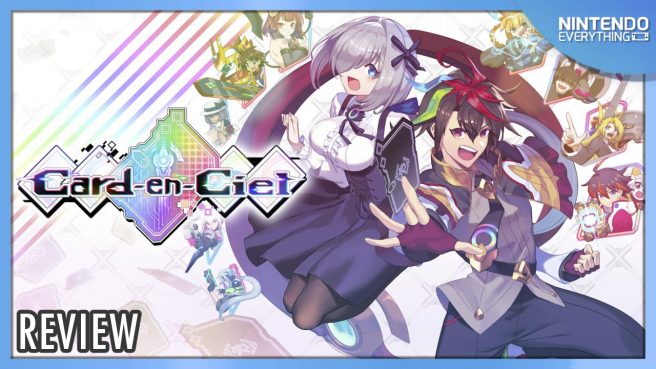[Review] Card-en-Ciel
System: Switch
Release date: October 24, 2024
Developer: Inti Creates
Publisher: Inti Creates
If there’s one thing I don’t think we get enough of these days, it’s video game crossovers and character cameos. There’s something delightful in watching characters from different series interact with one another in “what if” scenarios. Despite being a deckbuilder, which is a far cry from the 2D action games they are better known for, Card-en-Ciel feels like a love letter to Inti Creates’ catalog of releases up to this point, and it delivers a surprisingly deep combat system that somehow manages to stay fresh despite the repetition and roguelike trappings that occasionally throw off the pacing.
Card-en-Ciel introduces us to Neon, the self-styled “Gaming Chair Detective” whose mission is to put a stop to full-dive crimes, virtual world criminal activities so severe that they’re interfering with real-world life. Game data from other worlds is now crossing over as Mad Obstructive Data (MODs for short) and nobody knows why this is happening or who might be causing it. This has also resulted in the creation of dungeons, dangerous areas crawling with MODs from other game worlds that threaten the stability and peace of all worlds. Neon’s investigations result in him crossing paths with Ancie, who has built a deck of cards constructed of MOD data to combat the threat but is unable to utilize it herself because she lacks the necessary access to do so. As luck would have it Neon has the access necessary to make use of the deck, and he agrees to help Ancie resolve the problem by diving into various game worlds to find individuals with partition data, obtain said data by any means necessary, and restore the worlds.
It’s not the most original storyline, but the interaction between Neon and Ancie more than makes up for this. The banter between the two is always entertaining to watch, and although it never quite breaks the fourth wall, there are some very subtle nods to common anime and video game tropes as Neon tries (and often fails) to curb his enthusiasm for the game world they’re diving into, and Ancie’s reactions are often entirely unpredictable and quite surprising. It’s a fun little celebration of Inti Creates’ past releases, as over the course of the game you’ll dive into dungeons based on series such as Gal Gun and Azure Striker Gunvolt, as well as some original series that are either clever parodies of well-known franchises or, just possibly, a sneak peek at what the developer may be planning in the future. I was quite surprised to find that the game’s cutscenes were fully voiced with both English and Japanese language options, with many of the cards also having voice clips. These little catchphrases can become quite tedious after a while as they repeat ad nauseum when you play the card in battle, but the voice acting itself is of good quality.
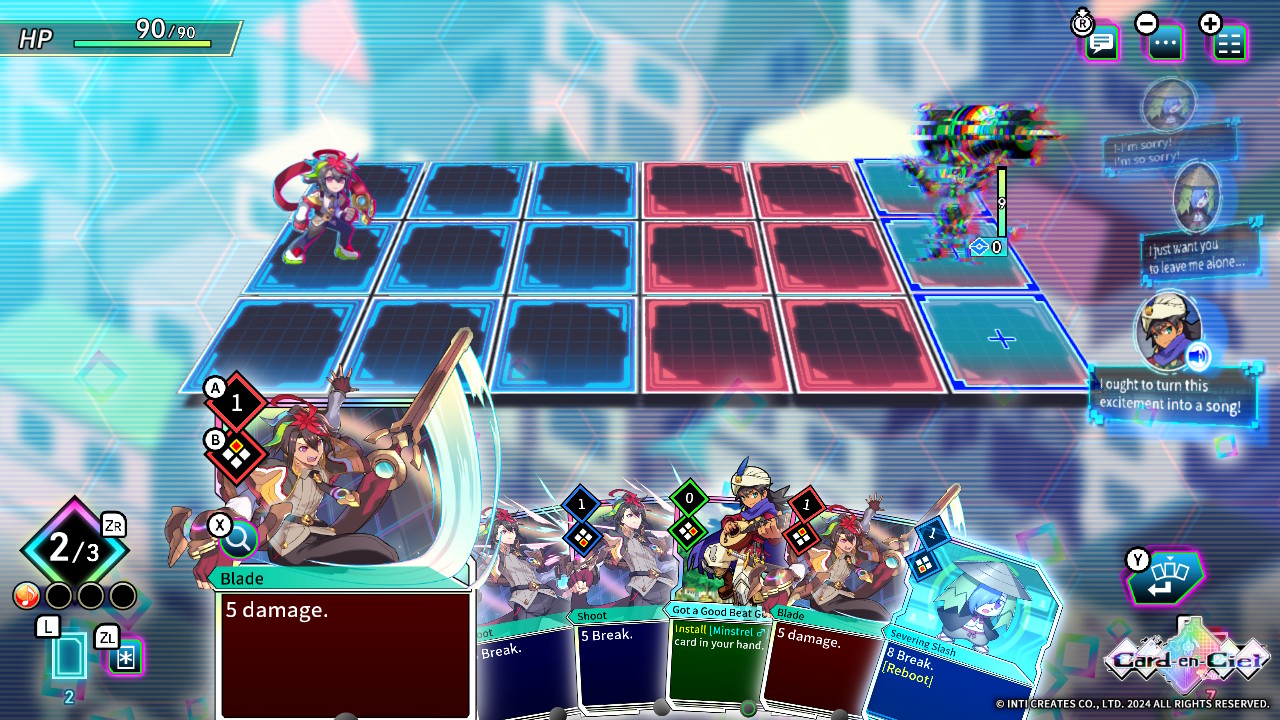
You’ll spend most of your time exploring dungeons in Card-en-Ciel, which are a series of interconnected squares that you can freely move between. Most squares contain either two moving enemies who will actively engage you or a more powerful stationary enemy. To progress, you simply need to defeat the boss enemy of the level you’re on to move to the next, and although you can simply run straight to the boss encounter for that level to move to the next if you choose, doing this would be inadvisable, as your starting deck is quite limited. Card-en-Ciel incorporates a roguelike element here by wiping the slate clean of all but a few cards each time you enter a dungeon, forcing you to build up your deck each time from scratch by defeating enemies contained within.
Moving between squares occupied by enemies will also build up your Memory Gauge, adding Trap Events in combat that will hinder your abilities in some way. Defeating all enemies on a single square will reward you with new cards for your deck, and also Subjugate that area, allowing you to choose one of three options: Recovery, which gives you back a portion of your health and Memory Gauge, Enhance, which applies a Cheat Code to one of the cards in your deck, or Position, which lets you station one of your own cards in that square for a support effect that will transfer to adjacent squares. So it is in your best interest to take your time on each floor and defeat enemies to gradually build up your deck before tackling the final boss on the third floor.
The lack of visual and audio distinction between each dungeon feels like a missed opportunity, as each one is named after one of Inti Creates’ past titles, or a title that parodies a well-known franchise, and the cards you’ll find are of characters from that series. Seeing this reflected in the dungeon design would have made the overall presentation much more engaging. From a narrative standpoint dungeons also feel very episodic in nature as the same scenario plays out in each one: Neon and Ancie dive into the world, find the main character of the franchise who are the source of the data leak, engage in battle with them, and then gain access to their powers as cards. The dialogue changes each time, as Neon gushes over the series and goes into an excessive amount of detail of its history whilst a baffled Ancie tries her best to keep up, but the story beats are generally identical across each.
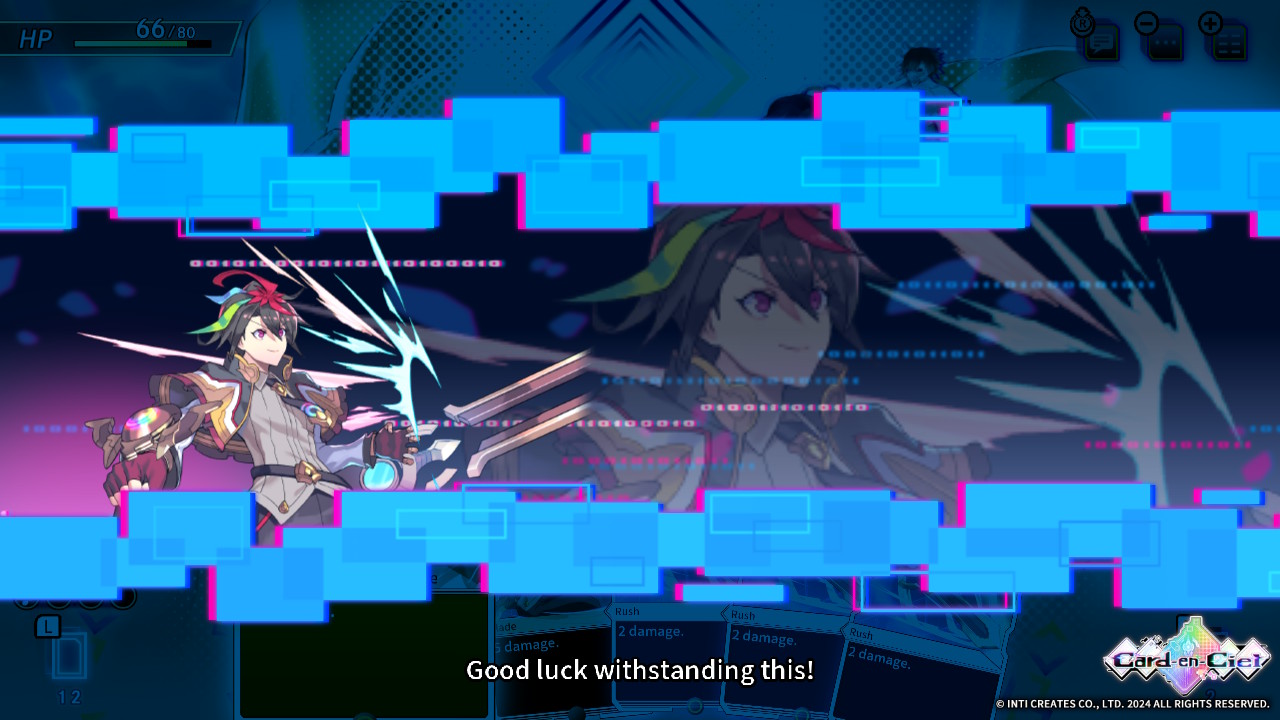
However I found that there was enough variety in the gameplay loop to prevent it from becoming stale, as each dungeon introduces new cards themed around the dungeon’s world to add to your deck, as well as new Cheat Codes to incorporate into your strategy. The Grand Battles that took place after a few dungeons, which add every card you’ve accumulated thus far to your deck and use cards in place of HP, felt like a satisfying way to bring everything I’d encountered up to that point together, and a lot like a mid-season finale from a narrative standpoint, as the plot progressed at these points.
Completing a dungeon will award you with a rank based on your performance, and a number of Tokens that can be used to Enhance Neon’s capabilities permanently. The roguelite elements of the game do feel a little forced here, as these permanent upgrades suffer from a problem that is quite common in the genre: they simply don’t offer enough of a tangible benefit to feel worthwhile, and subsequently don’t feel as though they’re worth grinding out repeated runs in the dungeon for. This can make failure feel frustrating at times, considering the RNG factor in both the cards you receive as a reward for winning battles and the hand you’re dealt during combat: sometimes, it’s just a matter of bad luck, leaving you with little choice but to re-attempt the dungeon and hope that you can recruit better cards from winning battles, and that the hands you’re dealt aren’t quite as poor as they were previously. On easy mode this isn’t much of a problem, as you are allowed to retry an infinite number of times if you fail in combat, and the ability to flee at any time mitigates the frustration on higher difficulties, although your mileage may vary with these mechanics.
Random mechanics aside, the card battle system that forms the backbone of Card-en-Ciel’s gameplay is satisfyingly robust and nuanced, and is easy to understand on a basic level. You’ll be placed on a grid split between you and your opponents, who will have a time counter that will reduce by 1 every time you play a card. Once it reaches zero, they will attack the area highlighted on your side of the grid. If you’ve ever played a Mega Man Battle Network title you’ll be familiar with the setup, although there are a few key differences that make Card-en-Ciel play quite differently from its inspiration. Combat here is turn-based, and the cards you use to defeat your foes will be selected randomly from your deck, meaning that you’ll need to be more strategic in what you choose to play and when.
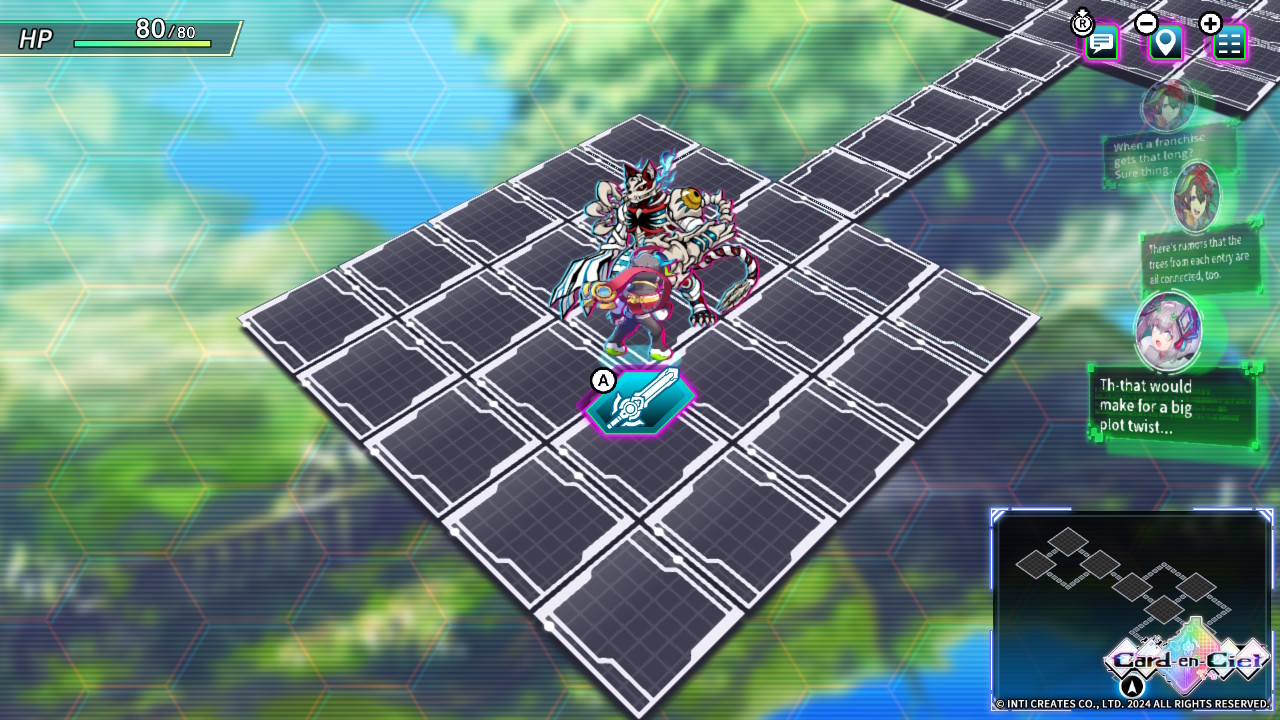
There are three different types of offensive cards that you can use: Attack cards inflict damage to an enemy’s health, Break cards reduce an enemy’s attack power and also leave them unable to attack and vulnerable to double damage for one turn when their Balance gauge is depleted, and Action cards allow you to evade and counter enemy attacks when used when their time counter reaches 1. There are also cards which provide passive bonuses, such as letting you draw additional cards or boost your damage capabilities. All cards also have a secondary Special Attack which can be used at any time, although doing this without a Muse’s energy will fracture them and render them unusable, making it a last ditch resort in most scenarios. Playing a card also comes with an associated cost, and the only ways to recover cost are to either break an enemies’ Balance gauge, via a card’s secondary effect, or to end your turn. Ending your turn will also refresh your hand, and allow your opponents to act immediately.
Of course, things become gradually more complicated as you progress, with most cards having Cheat Codes that you’ll need to take into consideration before playing them: some may need you to discard a card before you can play them, or can have their cost reduced under specific circumstances. Some can summon an ally to the field, or forge an additional card in your hand. Whilst the game’s tutorials cover the basics of combat extremely well, Cheat Codes are generally left for you to figure out for yourself, with the short descriptions of exactly what the effect means often not really providing an adequate descriptor for how this translates to what it does in practice. Some are easier to grasp than others, although more robust tutorials into what each effect does would have been welcome, especially considering just how many Cheat Codes there are and how much they can completely change a card’s effect.
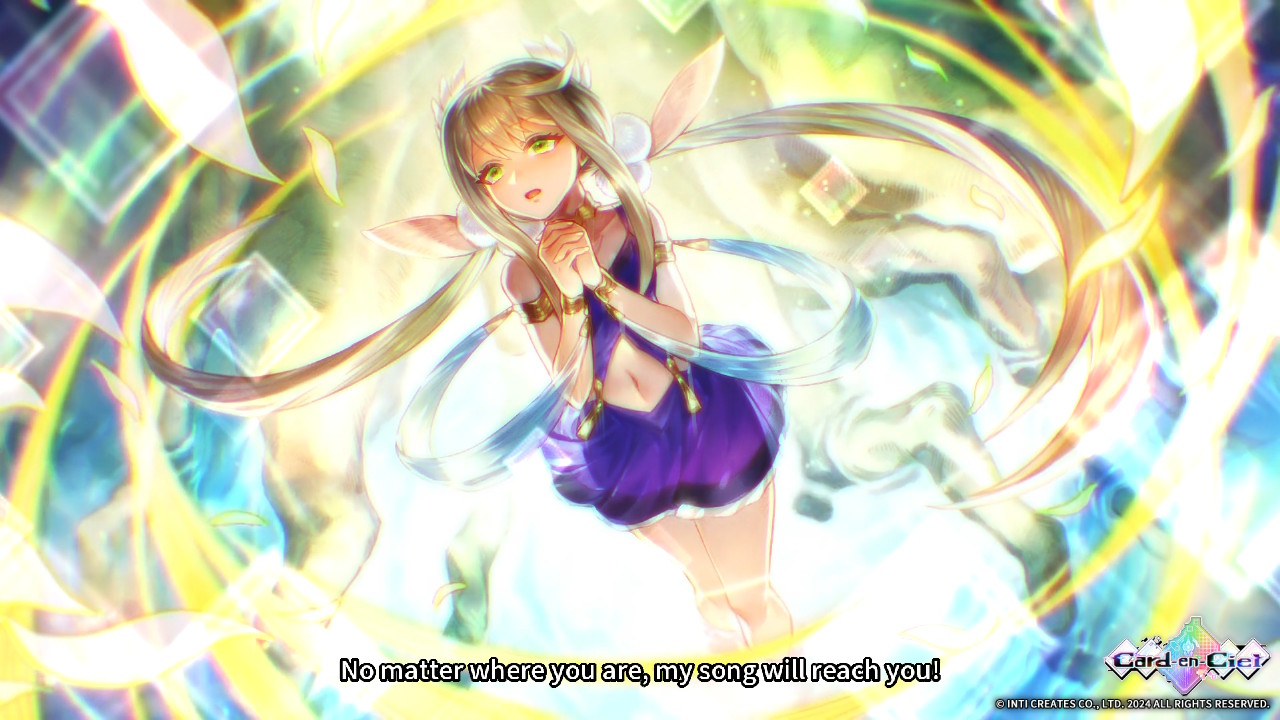
Cards can also be used to move in a specified direction on the grid at no cost (although it will reduce the enemy’s time counter) to evade enemy attacks, meaning that you will need to decide whether to play a card or use it to move out of the way of an oncoming enemy attack. This gives you another avenue for evading oncoming attacks, and although it was rare that I found myself completely unable to do this with the options I had available, it did occasionally come up during my playthrough, and on higher difficulties this can be quite frustrating to deal with.
Another major element to Card-en-Ciel’s combat are Muses, which are special cards that you won’t draw from your deck and can only be activated when certain conditions are met. Once activated, they will bestow useful effects in combat for that turn and provide you with blue energy, which can be used to trigger a card’s Special Skill without fracturing it. Leaving a Muse on a subjugated square will apply their Performance effect across adjacent squares. Enemy Muses will also be present on the field and will apply detrimental effects in a similar fashion until you defeat them in battle, which will then recruit them and let you use them yourself. When activated, Muses also change up the music of the dungeon, making things feel much more dynamic considering the lack of variety in presentation otherwise.
The Verdict

Card-en-Ciel is a fantastic love letter to Inti Creates’ games over the years, and a potentially exciting window into what the company might be planning to release in the future. It’s also the spiritual successor to the Mega Man Battle Network series that I never really knew that we’ve needed for years, and takes the unique gameplay that series established and evolves it in some interesting ways to provide a more strategic experience. The roguelike elements are an occasional source of frustration, but these moments are few and far between, and for fans of deckbuilders or Inti Creates’ work, this is a worthwhile use of your time.
A copy of Card-en-Ciel was provided by the publisher for the purpose of this review.
